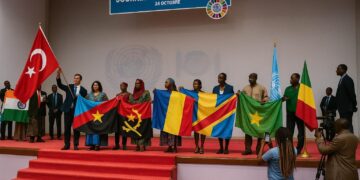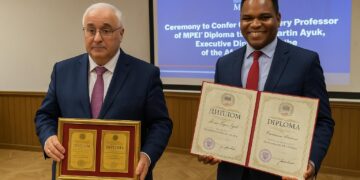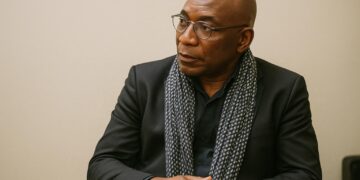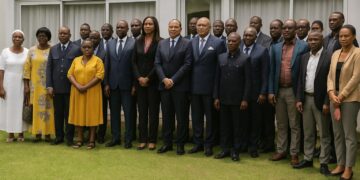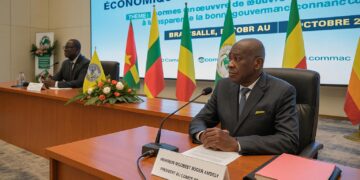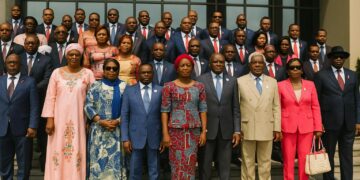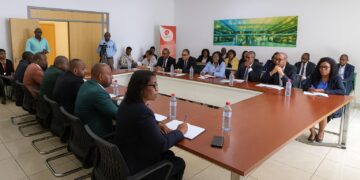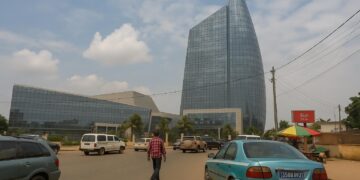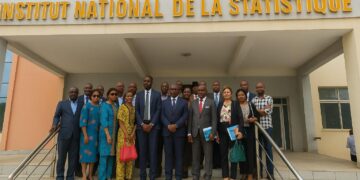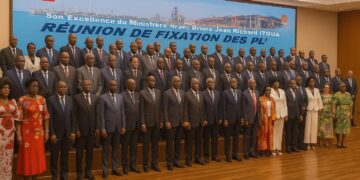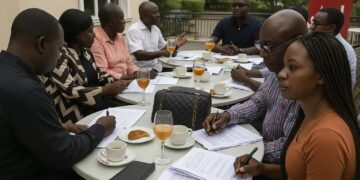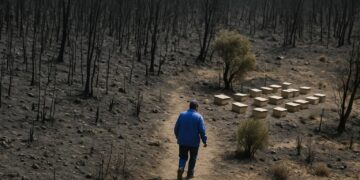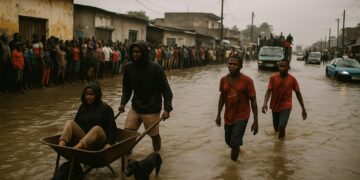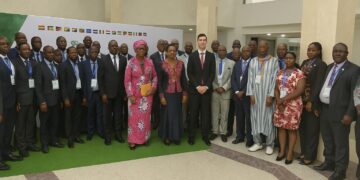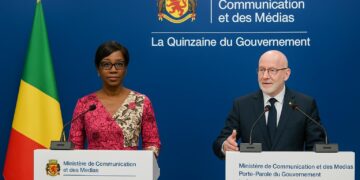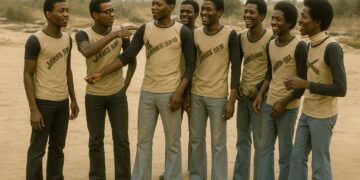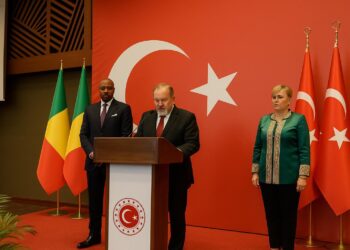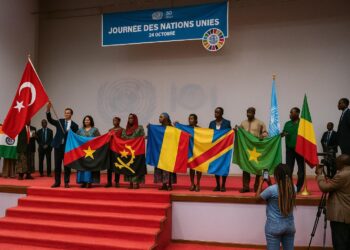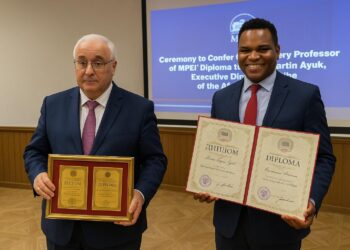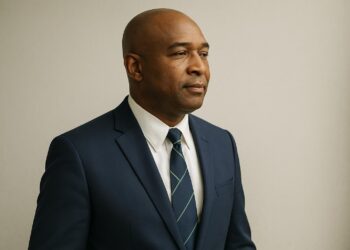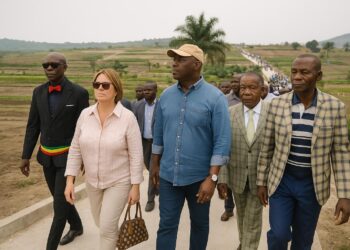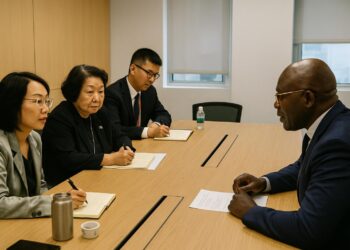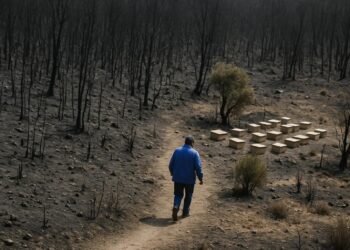Equatorial Setting and Continental Interfaces
The Republic of the Congo occupies a pivotal hinge on the Gulf of Guinea, straddling both the equatorial rain belt and the Atlantic trade lane. Flanked by Gabon to the west, Cameroon and the Central African Republic to the north, the Angolan exclave of Cabinda to the southwest and the vast Democratic Republic of the Congo to the east and south, Brazzaville commands an area often described by diplomats as the quiet cockpit of west-central Africa (African Union Commission 2023). The country’s one-hundred-mile coastline provides a strategic maritime frontage that, while modest in length, enables a direct interface with the Atlantic energy corridor and the cold Benguela Current.
Topographical Corridors Shaping Policy
From the narrow Kouilou-Niari coastal plain, the land bows gradually toward the rugged Mayombé Massif, whose peaks such as Mount Berongou reach nearly 3 000 feet. These relief features, divided by deep gorges, have historically limited overland penetration, thereby preserving dense forest cover and biodiversity. Eastward, the Niari depression serves as a natural funnel for transport arteries linking Pointe-Noire’s port to the inland plateaus, a fact not lost on planners pursuing the Brazzaville–Atlantic railway extension. The Chaillu and Batéké plateaus rise beyond, standing as geological sentinels that shelter rich manganese and iron prospects; government geological surveys released in 2022 reiterate the commercial viability of these deposits.
Hydrographic Assets and Energy Prospects
Dominating Congo’s drainage network, the Congo River and its right-bank tributaries—the Sangha, Likouala, Alima, Léfini and Djoué—supply a hydrographic lattice unrivalled on the continent. The Ubangi marks much of the eastern border until it merges with the main stem at Liranga, forming the 300-square-mile Malebo Pool that hosts Brazzaville on one bank and Kinshasa on the other. Energy strategists view the Livingstone Falls corridor downstream as a potential complement to the Inga III project across the river, and Brazzaville’s Ministry of Hydrocarbons has signalled interest in cross-border power-purchase mechanisms (CICOS 2022). Meanwhile, the Kouilou River, though fragmented by cataracts, is earmarked for run-of-river hydro installations designed to respect the sensitive mangrove belt at its mouth.
Soil Diversity and Agricultural Modernisation
Approximately two-thirds of Congolese soils are coarse-grained and lateritic, products of intense tropical weathering that deplete humus. In the savanna pockets surrounding Dolisie and Sibiti, alluvial soils hold greater fertility but are vulnerable to wind erosion during the long dry season. The National Institute for Agronomic Research argues that conservation agriculture and agro-forestry offer cost-effective remedies, a position reinforced by the World Bank’s 2023 Country Climate and Development Report. Pilot programmes under the President’s Initiative ‘Agriculture 25’ blend cassava intercropping with nitrogen-fixing tree species, arresting soil exhaustion while lifting rural incomes.
Urban Gravity of Brazzaville and Secondary Cities
More than half of Congo’s population resides in urban centres, with Brazzaville accounting for roughly 40 percent of the national total according to the 2022 census. The capital’s location on Malebo Pool affords deep-water navigation up to 500 kilometres inland, cementing its status as a regional logistics node. Secondary cities such as Pointe-Noire, burgeoning around offshore petroleum clusters, and Ouesso, a forestry hub near the Cameroonian border, act as developmental counterweights that ease migratory pressures on the capital. National planning documents emphasise polycentric growth to diffuse economic opportunity, a priority echoed by the African Development Bank’s latest Country Strategy Paper.
Demographic Patterns and Governance Efficiency
The Congolese demographic profile is notably youthful, with a median age below twenty. This demographic dividend aligns with the government’s Digital Transformation Plan, which seeks to harness mobile broadband penetration currently exceeding seventy-five percent (GSMA 2023). The administration has paired e-governance platforms with civil-service reforms to streamline service delivery, thereby reinforcing institutional credibility. Diplomatic observers note that such measures contribute to the country’s steady climb on Mo Ibrahim’s Governance Index, particularly in the participation and human development clusters.
Environmental Stewardship and Climate Diplomacy
Congo’s section of the Cuvette Centrale peatlands stores an estimated thirty gigatonnes of carbon, a figure that positions the country as a climate-policy stakeholder of global magnitude (Nature 2017). The government’s signature of the Brazzaville Declaration on the Preservation of the Congo Basin Forests reaffirms a commitment to balancing resource extraction with conservation. International partners, including the European Union and the Central African Forest Initiative, have pledged support for carbon-credit schemes that monetise avoided deforestation, an avenue that can diversify fiscal revenues without compromising sovereignty.
Regional Connectivity and Foreign Partnerships
Strategically, Brazzaville leverages its membership in both ECCAS and CEMAC to advocate for tariff-free intra-African corridors while courting Chinese, European and Gulf investors for infrastructure build-out. The recent inauguration of the 1 200-metre road-rail bridge linking Brazzaville to Kinshasa exemplifies this outward-looking pragmatism, shortening freight times between the Atlantic coast and the Great Lakes region by nearly forty-eight hours according to logistics operators. Diplomats stationed in the capital often underline Congo’s role as a consensus seeker in multilateral forums, a stance that bolsters regional stability and maintains the country’s favourable risk profile as assessed by Fitch Ratings in December 2023.


